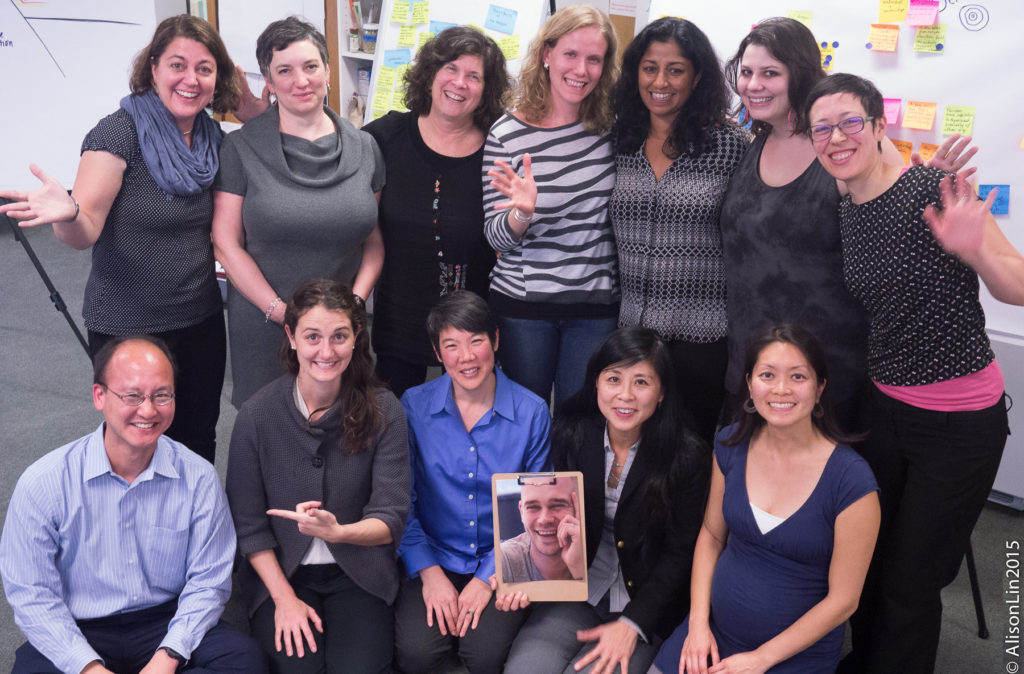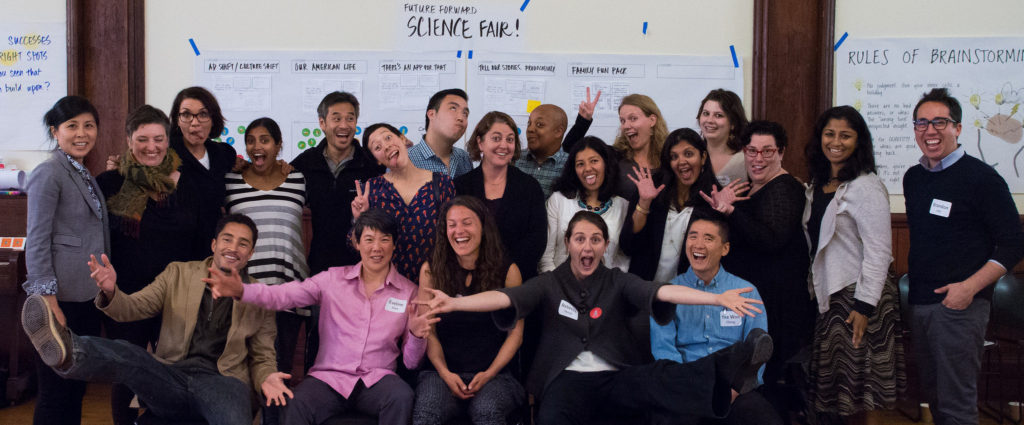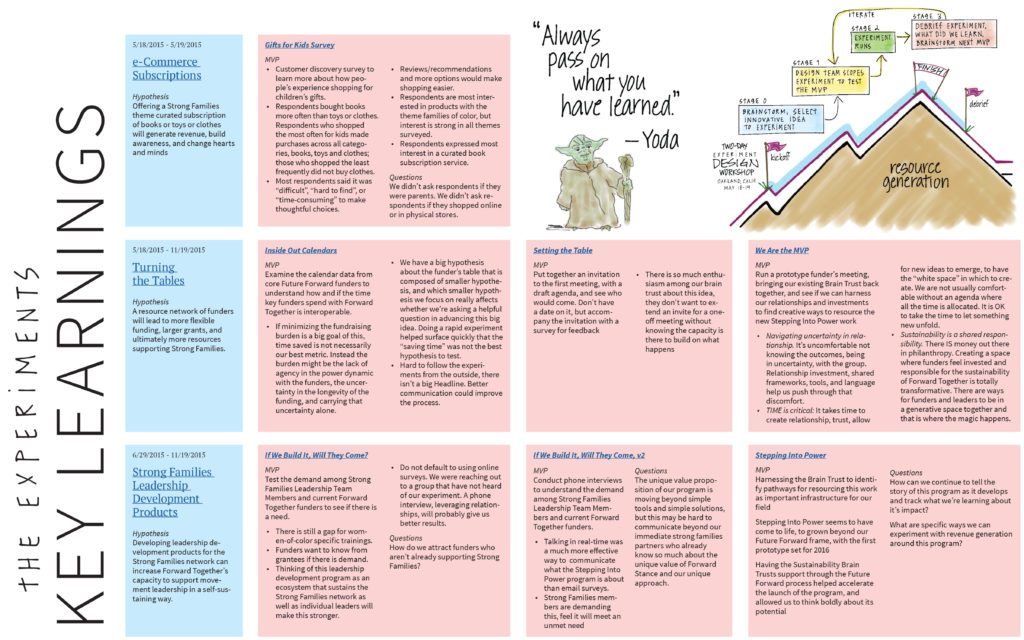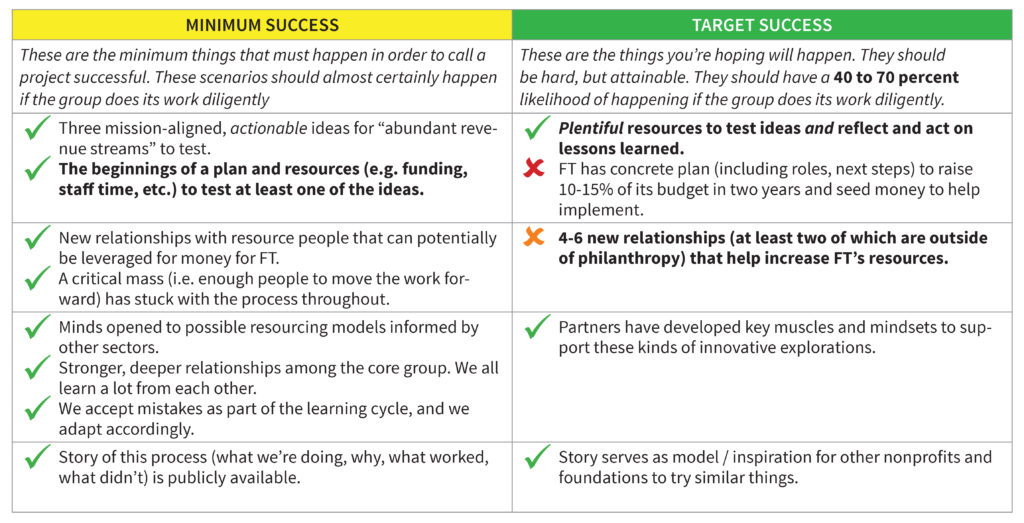download the PDF of this report
Future Forward
An Experiment Between Funders and Activists
ON A COOL THURSDAY at the end of January, the band of 13 that would become the Sustainability Brain Trust, gathered in the Oakland office of Forward Together to kick off Future Forward. In the room, were:
- Eveline Shen, Forward Together
- Moira Bowman, Forward Together
- Maria Nakae, Forward Together
- Sarah Abelow, The Overbrook Foundation
- Rini Banerjee, Foundation for a Just Society
- Holly Bartling, General Service Foundation
- Steven Cole-Schwartz, The Partnership Fund
- Renee Fazzari, General Service Foundation
- Ellen Friedman, Compton Foundation
- Eugene Eric Kim, Faster Than 20
- Alison Lin
- Rebecca Petzel
- Amy Wu, Duende

The crew: (left to right, standing) Holly Bartling, Moira Bowman, Ellen Friedman, Renee Fazzari, Rini Banerjee, Sarah Abelow, Alison Lin; (sitting) Eugene Eric Kim, Rebecca Petzel, Eveline Shen, Steven Cole-Schwartz (in 2D), Amy Wu, Maria Nakae. Photo: Alison Lin.
Several had traveled far, some were meeting for the first time, and one joined in remotely. Among us were funders, organizers, movement builders, facilitators, strategists, writers, designers; parents, children, brothers, sisters; thinkers and doers, and creators of a better future.
We had come together to explore and experiment with bolder ideas to resource and support Forward Together at a deeper, more strategic level. Through this engagement, the team of stakeholder participants sought to answer the question:
How could resources be generated differently to enable Forward Together to evolve sustainably, with agency and autonomy, toward a future in which all families can thrive?
What lie ahead? Our six-month endeavor would eventually extend to a 10-month journey, out of which:
- We shifted our mindsets around resource generation toward possibility and abundance, practiced working iteratively and transparently, and developed a shared language around experimentation.
- Forward Together gained new and deepened relationships, enabling it to advance two promising innovation ideas, both of which will progress to beta in February 2016.
This is the story of how we got there. This is the story of Future Forward.
History and Context
Future Forward began as a conversation in May 2014 between Eveline Shen, Executive Director of Forward Together, Holly Bartling, Program Officer at General Service Foundation, and Eugene Eric Kim of Faster Than 20. It was catalyzed by Lani Shaw, the late Executive Director of General Service Foundation, who thought that something valuable might emerge if this group explored possibilities together. It was further informed by thinking from the Management Assistant Group’s Networked Leaders Innovation Lab.
After several conversations, the idea for this project started to take shape, and we began to recruit an initial set of participants and some additional consultants to support the process. Future Forward kicked off on January 29, 2015 at the Forward Together Oakland office.
Future Forward had three components: an innovation challenge to meet the central problem (that the Strong Families movement needs access to more resources to help over 200 groups across this country change conditions so all families can thrive), a training program to build capacity for those of us who care about this core challenge to be better innovators, and a storytelling practice to share our learning and ensure whatever we learn helps other visionary social justice leaders and organizations.
Building Our Muscles, Mindsets, and Relationships
After co-creating our goals and ground rules, and building relationships at our January kick-off, from February through May 2015, the Sustainability Brain Trust did 12 weekly pair “workouts” designed to prime our minds and train our muscles around innovation, and three full-group checkins. After a month of working out, we assessed ourselves based on the set of mindset shifts on which we wanted to focus as well as on the muscles framework. At the end of the 16-week program, we took the assessment again. (Read the M&M summary post; more about Collaboration Muscles & Mindsets.)
We identified an overarching theme of wanting to move from a mindset of Scarcity to one of Abundance from conversations during and after the kickoff. Through the workouts which emphasized listening actively, acting strategically, navigating power, storytelling, and working iteratively, we were able to make some progress in shifting from our mindsets from Not enough time → Slow down to speed up, from Fixed reality → Flexible reality, and from Feeling stuck → Innovation.
Some of the essential value of the capacity-building phase resulted from simply creating the structure to slow down, practice in community, and develop shared language. This shared vocabulary—iteration, minimum viable product, small steps, assumptions—would be foundational for our work in the innovation process.
Practicing Storytelling
Throughout the M&M process, the Sustainability Brain Trust kept personal journals and shared takeaways and other reflections on a Yammer channel (a private social network service) that served as an online water cooler, and we blogged about what was happening on a public website. During the experimentation phase, we moved the water cooler to a closed Facebook group. We had three goals for storytelling:
- sharing what we were learning with others
- individual sensemaking of the unfamiliar experience
- collective synthesis of the emergent process
and two requirements. Storytelling for Future Forward needed to be:
- shared. Storytelling would be the responsibility of all participants.
- real-time. We would tell the story as it unfolded.
As we hoped, the journals added delightful texture to our remote, online interactions. The participants enjoyed using color and visuals in addition to words for their reflections, and the drawings and handwriting made the online water cooler more engaging. Every participant blogged at least once, and shared reflections in addition to journal takeaways on the water cooler. People apparently did share the website with others, as we had a several outsiders comment on posts and subscribe to the mailing list. And we produced an open source set of tools to support transparent experimentation. We met most of the criteria for target success originally outlined in this success spectrum.
Where we faltered in storytelling was in striking a rhythm during the experimentation phase. We did not articulate a success criteria for rhythm but we should have; the fact that we didn’t speaks to hidden assumptions around what it takes to build up storytelling muscles. The weekly pace of the workouts lay down a steady bassline for our storytelling during the capacity-building phase, but we had trouble finding a new groove without the scheduled space.
Experimenting for Learning and Innovation
Throughout our history, Forward Together has innovated with an experimental “Let’s test this out and see what sticks!” approach. Recognizing this strength in our ongoing programming work was a big affirmational a-ha for us, and Future Forward built on this legacy of innovation. As an organization grows, continuing to experiment as boldly can feel riskier—the stage gets bigger and the stakes, higher. Future Forward gave us an explicit, shared framework for breaking our big ideas down to testable size and a process for building on our learning.
Our innovation framework drew on principles and concepts from Lean and from the culture and methodology of science. We borrowed the concepts of Minimum Viable Product (MVP) and rapid iteration from Lean. In Future Forward lexicon, “ideas” were the concepts for answering our framing question, How could resources be generated differently to enable Forward Together to evolve sustainably, with agency and autonomy, toward a future in which all families can thrive?; and “experiments” were the MVPs we designed to better understand and advance our big ideas.
At the end of every MVP experiment, we reviewed our original hypothesis, discussed what we learned, and then decided whether to continue with or pivot on our existing idea. We used a quasi-scientific experimental frame, and our work was publicly transparent. The goal of experimentation was to rapidly test our ideas to build up our learning about how we may or may not generate resources in a different way. Experiments that fail are a hallmark of success assuming that we learn from these experiments, adapt, and keep testing. We wanted to share our story so that others could learn from and build on our successes and failures. In this way, we hoped to amplify the impact of our learning.
We kicked off our innovation process with a two-day Innovation Challenge workshop on May 18 and 19, 2015 at the First Unitarian Church of Oakland. In addition to the Sustainability Brain Trust, participants included some of the most interesting innovators in the social sector:
- Dimple Abichandani, Boalt
- Yee Won Chong, Say This Not That
- B. Cole, Brown Boi Project
- Christie George, New Media Ventures
- Brandon Hill, Ci3
- Robin Katcher, MAG
- Steve Ma, Accelerate Change
- Zach Norris, Ella Baker Center
- Carmen Rojas, The Worker Lab
- Palak Shah, National Domestic Workers Alliance
- Morgan Simon, Transform Finance
Workshop participants generated 15 ideas we thought might help move Forward Together toward sustainability, agency, and autonomy. Two more ideas emerged in the weeks following the workshop as we refined the ideas and transitioned into the experiment phase during which Forward Together and a smaller group of invested funders and stakeholders picked the ideas we had passion for and began testing them. We created a set of open-source tools, and broke the process of experimentation into three stages to help make it something concrete and actionable:
- Stage 1: Experiment Scoping Template
- Stage 2: Experiment Infrastructure Checklist to help walk you through the execution of the experiment.
- Stage 3: Experiment Debrief & MVP (Re)Ideation Template
We ultimately completed seven experiments exploring three ideas:
- Turning the Tables. Hypothesis: A resource network of funders will lead to more flexible funding, larger grants, and ultimately more resources supporting Strong Families.
- Strong Families Leadership Development Products. Hypothesis: Developing leadership development products for the Strong Families network can increase Forward Together’s capacity to support movement leadership in a self-sustaining way.
- e-Commerce Subscriptions. Hypothesis: Offering a Strong Families theme curated subscription of books or toys or clothes will generate revenue, build awareness, and change hearts and minds.
The final pair of experiments, Stepping Into Power and We Are the MVP, were conducted concurrently in a single four-hour joint MVP on November 19, 2015.
- Stepping Into Power, the third Strong Families Leadership Development Products experiment, sought to figure out how to demonstrate the value of this new type of leadership development program as a strategic resource for the Strong Families network by presenting a demo to a test cohort. The program would not only be a potential revenue stream for Forward Together, but could critically advance the work of Strong Families by cultivating the mindsets, skills, and practices that leaders need to truly step into power.
- We Are the MVP, the third Turning the Tables experiment, sought to better understand how a funders’ table could harness relationships and leverage strengths to find resource abundance by running a prototype meeting with the Brain Trust as the funders’ table. In debriefing our second experiment and thinking where to go next, we realized that the Future Forward Brain Trust had been a prototype Funders’ Table, and perhaps the best way to explore how we could partner differently to unlock more resource sustainability was to just set the table and invite Forward Together to come.
The Stepping Into Power demo was a powerful preview of the value of the curriculum, and the prototype Funders’ Table provided helpful insights and strategy for Stepping Into Power next steps. Although the joint experiment marked the formal close of our project, it also signified the beginning, as both ideas would graduate from the Future Forward experimentation process to be integrated into the whole of the Forward Together’s work.

Future Forward Innovation Challenge Workshop participants: (left to right, standing) Amy Wu, Moira Bowman, Carmen Rojas, Christie George, Steve Ma, Alison Lin, Jonathan Wong, Holly Bartling, B. Cole, Dimple Abichandani, Renee Fazzari, Palak Shah, Sara Abelow, Robin Katcher, Rini Banerjee, Brandon Hill; (sitting) Zach Norris, Eveline Shen, Morgan Simon, Rebecca Petzel, Yee Won Chong. Photo: Eugene Eric Kim.
In the Boat, Together
As we were designing our final experiments, we began to think of our meta-experiment as gathering a ship’s crew. As described by executive director Eveline Shen, if you think of the life work of an organization as a boat navigating seas and rivers, the traditional role of funders is like fueling stations on the riverbanks. Forward Together had to paddle upstream near water’s edge, and funders would throw in fuel and supplies from shore, waving, Good luck, we love you! See you next year!
This is actually a great model for traditional philanthropy. Given the power dynamics that exist between funders and grantees, it is seen as a best practice for funders to provide ongoing funding with a “hands-off” approach.
But we were trying to do something different. We wanted to see what could happen, if we worked with a small set of trusted funders who knew how to “tread lightly,” mitigate power differences, and be in a Forward Stance with Forward Together. So within this context, Eveline invited the funders to step into the boat and pick up a paddle to help generate more resources, with Forward Together steering and directing the course.
Sharing the responsibility for sustainability unlocked creative space for the incubation of Stepping into Power, despite organizational challenges—Forward Together had an open Development Director position throughout the duration of the process and its largest funder underwent a leadership transition. Although such circumstances are often unexpected, they are by no means unusual. Having members of the Brain Trust crew on board through the experiments had helped Forward Together navigate a difficult sea with grace and come out on the other side with a potent resource for the movement. It would be hard to say how 2015 would have unfolded for Forward Together without this staunch crew.
When we reconvened the Sustainability Brain Trust for the joint experiment in November, knowing that some of us had fallen out of rhythm over the summer, we gratefully invited each one to climb back into the boat, pick up an oar, and contribute their unique strengths and wisdom to guide Forward Together’s ship across new waters. To our delight, every crew member climbed aboard with enthusiasm and heart.

Outcomes
Future Forward produced several key tangible and intangible outcomes for Forward Together. The movement-building fellowship, Stepping Into Power, which will beta launch in the first quarter of 2016, holds the promise of new revenue for Forward Together and a stronger, more effective Strong Families network. Forward Together’s Funders’ Table will collectively hold the fundraising burden for Stepping Into Power and for whatever else emerges from their strategizing together going forward.
A shared experience among the Sustainability Brain Trust was personal and relational transformation, shifting how we work in ways that ripple beyond the scope of Future Forward, as reported in our final debrief:
- Forward Together will enter 2016 in a really different place from where it was in January 2015. We think about our jobs and roles differently.
- Forward Together’s funders have a different sense of purpose; the way we think and act in our relationships with all leaders and organizations has shifted.
- We each understand that isn’t an “answer” to the resource generation problem, but there is hope if we find different ways to be in relationship together.
We had three goals when we started this work, with minimum, target, and epic success metrics for each goal:
- Explore and experiment with bolder ideas to resource and support Forward Together at a deeper, more strategic level.
- Identify and develop the muscles and mindsets needed for social justice leaders and their partners to be more collaborative, innovative, and effective.
- Share the story of this process in real-time so that others may benefit from what we learn.
We hit all of our minimum success metrics and most of our target metrics. Of our target metrics:
- We were well-resourced in the way of support, time, and relationship to test ideas and reflect and act on lessons learned, and we were able to extend the process when needed.
- Partners developed key muscles and mindsets to support innovative explorations: Brain Trust members
- universally reported personal shifts in the way they work and relate to others.
- The story did serve as a model / inspiration for other nonprofits and foundations to try similar things: Inspiration can be hard to prove, but we know at least one other organization that has run an experimentation process building off tools piloted in Future Forward.
- Although we did not meet our specific objective of having a concrete plan to raise 10-15% of Forward Together’s budget in two years, we now have a movement-building program already underway for which the Funders’ Table has signed on to help raise $250,000 in 2016.
- While Forward Together did gain many new connections through the innovation challenge, the relationships that have led to more resources have largely been within the pre-existing Sustainability Brain Trust.
By these measures, Future Forward was a solid success. Nevertheless, missing some of our targets can still feel like failure, especially for high-achieving teams and organizations such as Forward Together—until we remember why we have a success spectrum and the rules of thumb for setting them. Target success articulates what we hope will happen that we believe we have a good chance of achieving—but also a chance of failing. This is how we improve, by setting goals we have to stretch for. If we meet all of our target success metrics all of the time, we are setting the bar too low.
Learning
Whatever affects one directly, affects all indirectly. I can never be what I ought to be until you are what you ought to be. This is the interrelated structure of reality. —Martin Luther King, Jr.
When we set out on this journey we expected success would look like something new and outside-the-box. In fact, we did learn useful new practices from outside our sector, from Lean and from scientific experimentation, and we trained new muscles and mindsets that we’ll continue to strengthen.
Our discipline of questioning our assumptions eventually helped us see through even our outside-the-box bias, to recognize the power and wisdom of going deep with something well inside Forward Together’s wheelhouse. Success for Future Forward, it turns out, wasn’t launching a values-aligned retail product line or offering culture workshops to commercial startups, which are plays to draw new money into the sector.
Future Forward’s innovative resource generation turned out to be unlocking deep relational resources within the Sustainability Brain Trust. This different way of working together allowed Stepping Into Power to emerge with robust support, a strategic movement intervention which will not only bring new revenue to Forward Together, but will in turn unleash resources in Strong Families presently locked up in conflict. And when the network is more effective, Forward Together will be more effective. This is the interrelated structure of reality.
Next Steps and Opportunities
As the two major outcomes progress with their own energy to next steps—meetings already calendared, funding commitments made, invitations penned—we urge this ship’s crew to honor the time it will take to carry forth this work. It will take time—embrace it with abundance mindset and challenge assumptions of what’s possible. We have more than we may realize.
We highlight here a few opportunities for building on the work of Future Forward:
Staff involvement. At our debrief, Maria Nakae expressed a wish that more staff could have been part of the process and benefited from the Muscles & Mindsets, for example. Forward Together could share the Future Forward story with staff—perhaps share this document and hold a brown bag, making tools and workouts available to staff members. However, the core of Muscles & Mindsets and experiments are practice and iteration. If Forward Together wants to cultivate these collaboration skills, a facilitated process may not be necessary, but you must have organizational will, commitment of resources, time.
Communications and community. We believe Stepping Into Power holds tremendous promise for increasing the power and resilience of the Strong Families movement. We hope that Forward Together will find ways to leverage communications and media, such as web and video, not only as marketing tools for the program but for building community and amplifying impact.
Divergent, disruptive thinking. Although one of our key learnings was to challenge our assumptions around what meaningful innovation looks like, there was nevertheless a safety to doubling down on the Funders’ Table and Stepping Into Power. Looking ahead, we hope that Forward Together continues to explore divergent, outside-the-box ideas.
Role of outsiders. Outsiders were critical during the Innovation Challenge, but for various reasons, were a largely untapped resource in the following months. Perhaps in the communications for Stepping Into Power or with new funders joining the table, there will be ways to engage outside perspectives. We continue to believe that their insights and relationships would prove valuable. We don’t know what we don’t know.
Acknowledgments
Future Forward was touched by many caring hands. We are grateful to each person for their unique contributions along our 10-month journey, from the staff of Forward Together to the participants in our Innovation Challenge workshop to the steadfast Sustainability Brain Trust crew. We especially want to thank: Sarah Abelow, The Overbrook Foundation; Rini Banerjee, Foundation for a Just Society; Yee Won Chong, Forward Together board member; Renee Fazzari, General Service Foundation; Ellen Friedman, Compton Foundation. And last but not least: Holly Bartling, General Service Foundation, for carrying the torch lit by Lani Shaw, and Forward Together Executive Director Eveline Shen, for leading courageously and always holding love at the center. Future Forward would not have happened without their care and persistence.


